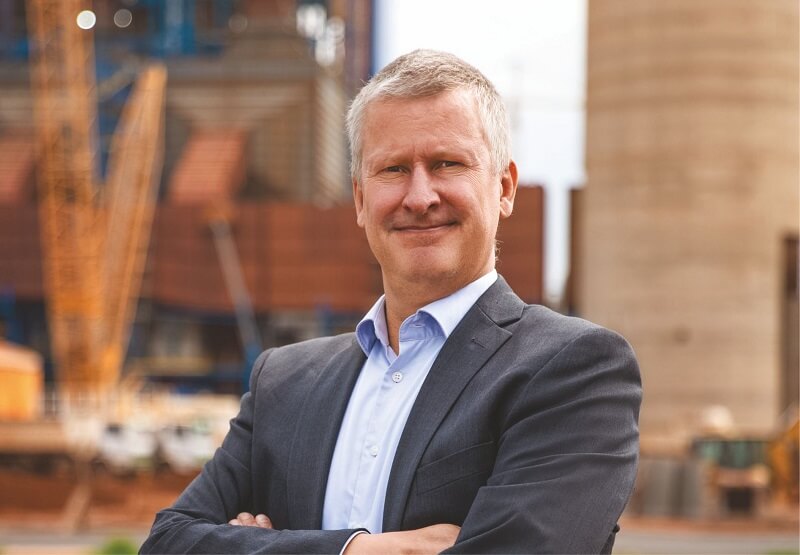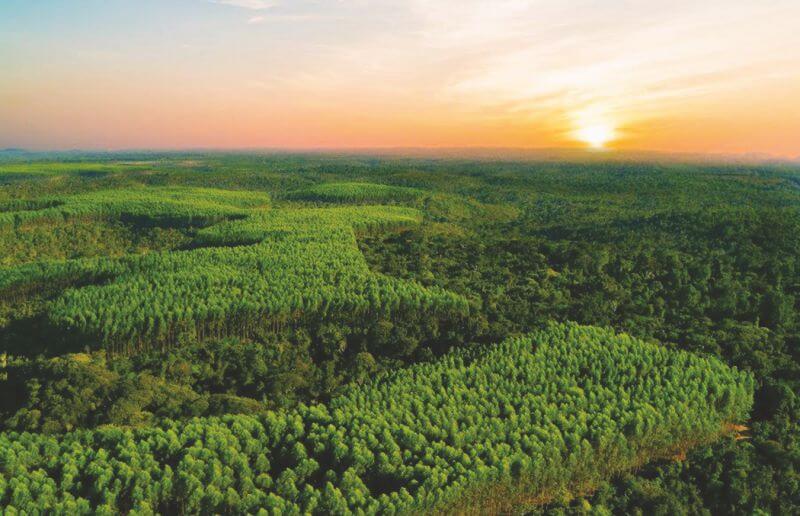Bracell, recognized as one of the global leaders in the production of dissolving pulp and specialty cellulose, has deployed innovative technologies. In 2019, the company invested in building the largest and greenest pulp mill in the world, located in Lençóis Paulista, São Paulo, Brazil. This came to be known as Project Star, becoming a landmark investment in Bracell’s history and the largest-ever private investment in the State of São Paulo in the last 20 years.

In an exclusive conversation with Paper Mart, Mr. Per Lindblom, Executive Vice President, Bracell, talks about the strong environmental commitment of the pulp mill, details about Project Star, and the importance of being the “new generation pulp mill”. Further, he also presents insights on the growing sustainability in the pulp industry, the current market presence of Bracell, and the future roadmap.
Paper Mart: Tell us about the Bracell overview and key company milestones.
Per Lindblom: Bracell is a company that is constantly growing and investing in large projects, following its main commitment to sustainability. With more than 4,700 employees in Brazil, we are very proud of our development over the last few years. In 2019, we made a huge investment to build the largest and greenest pulp mill in the world, located in Lençóis Paulista, São Paulo. Known as Project Star, this was a milestone in Bracell’s history and will continue to be remembered as the largest private investment in the State of São Paulo in the last 20 years.
The new plant, which is part of an ambitious expansion project of the company in São Paulo, has the capacity to produce 1.5 million tons of dissolving pulp and up to 3 million tons of kraft pulp per year. With the start of operations at the new plant in September 2021, Bracell became the largest producer of dissolving pulp in the world.
Nowadays, Bracell has a production capacity of 80 million seedlings per year. In 2021, the company produced 59.8 million seedlings, being 26.8 million in Bahia and 33 million in São Paulo. In addition, the Forest Protection Complex in Alagoinhas (BA), a place with three laboratories dedicated to the identification, research and development of pest control solutions, was also inaugurated. The company’s social investments are made by Bracell Social. We invested more than R$4 million in social projects that reached more than 100 thousand people.
There was also the construction of the Intermodal Terminal in Pederneiras (SP) in partnership with MRS Logística to transport the pulp to the Port of Santos. The pulp is transported by truck to the terminal and from there is transported by train to Santos Port. Each composition consists of up to 3 locomotives and 67 wagons and transports a volume equivalent to what can be transported by 120 trucks. We have 463 wagons of our own to support the transportation and we already have a study for the implementation of electric trucks to reduce carbon emissions.
This year, we launched another great initiative. The “One-For-One Commitment”, unprecedented in the Brazilian pulp sector, will contribute to the conservation of native vegetation areas equal in size to the plantation areas. For every one hectare of eucalyptus planted, Bracell is committed to conserving one hectare of the native area. The goal will be reached by the end of 2025. It is an important step for Bracell in its sustainability strategy, which is fully aligned with the company’s values.
Currently, the ratio between the company’s cultivated areas and conservation areas is 0.56. This initiative is important because it expands the company’s area of activity in the conservation of biodiversity beyond our areas of operation. We have adopted this commitment on a permanent basis. So, if the company increases the areas of eucalyptus plantations after 2025, proportionally, the total number of conserved areas will also be increased, to maintain the “One-For-One Commitment”. In addition to conserving existing native areas in Bracell’s production areas, the commitment will support conservation in public areas and the recovery of degraded areas through partnerships with governments and other institutions. It will also help to prevent and fight forest fires, deforestation and theft of native wood, illegal hunting, and capture of wild animals.
“Our operations are guided by our commitment that everything we do must be good for the country, the climate, the communities, and the customers… This is part of our philosophy and our commitment to sustainable development in all our operations”
PM: How do you think this will play a role in strengthening Bracell’s position as one of the largest and most sustainable pulp mills in the world?
PL: As mentioned earlier, the completion of Project Star is a milestone in the company’s history. We are very proud to be pioneers in the construction of a new generation pulp mill, which provides flexible and biodegradable products using the most advanced technology.
Bracell is one of the leaders in the production of dissolving pulp, including specialty pulp and our mill is at the forefront of innovation in the sector. In other words, this only reinforces our competitiveness and our capacity to bring products of the highest quality to the market.
Watch: IVAX Paper Chemicals Interview
PM: Tell us more about Project Star technologies and infrastructure. Also, clarify the manufacturing capabilities you intend to achieve with the project.
PL: In addition to being the largest and greenest pulp mill in the world, using cutting-edge technologies that minimize the environmental impacts of the operation, the new plant has the capacity to produce 1.5 million tons of dissolving pulp and up to 3 million tons of kraft pulp per year. We have the largest recovery boiler in the world and the first biomass gasifier in operation in the pulp & paper sector in South America. Over the next two years, production planning will be carried out in stages, focusing on the operational stability of the two lines. After this period, the lines will be used to produce either dissolving or Kraft pulp, according to the demands of the company and the market.
The gasification plant uses 100 percent renewable biomass as a raw material to produce biogas. Trees are grown in areas that were previously pasture or degraded, which helps to absorb carbon dioxide from the atmosphere, contributing to climate mitigation.
We are self-sufficient in energy for the plant’s operations and the surplus energy generated is distributed to the national grid. As the pulp production process generates by-products that can be reused, the company took a strategic decision to invest in state-of-the-art equipment and high technology in its process cycles. We have built a new 440 KV substation connected to the transmission network with GIS (Inflated Gas) technology. The installed capacity is 409 MW, powered by three turbogenerators that are sufficient to meet the factory’s demand while also allowing us to export to the SIN (National Interconnected System) network around 150-180 MW of surplus energy from renewable sources, without Greenhouse Gas (GHG) emissions. This surplus energy is capable of serving 750,000 homes or around three million people.

PM: As a “Next Generation Pulp Mill”, what will be your main approach to bring more value creation and innovations to the pulp sector?
PL: The goal is for our entire value chain to be sustainable. The pulp we produce is a raw material from a high quality renewable source, used in the production of biodegradable products, which are present in the daily lives of thousands of people.
The company is always evaluating the best alternatives for investment and growth in the markets in which it operates, especially in Latin America. As an example, in addition to the expansion of the São Paulo unit, Bracell evaluated some opportunities in the downstream pulp segment (consumer goods) that could add value to its pulp and decided to invest in a tissue factory in its São Paulo unit.
This project is expected to generate more than 2,000 jobs during its construction phase and approximately 300 permanent jobs after its completion. We had issued a Notice-To-Proceed for 4 Andritz tissue machines of 240,000 tons per year capacity. The 4 machines are expected to start up from 2Q 2024.
“
Project Star was a milestone in Bracell’s history… The new plant, part of an ambitious expansion project of the company, has the capacity to produce 1.5 million tons of dissolving pulp and up to 3 million tons of kraft pulp
”
PM: What is Bracell’s current market presence worldwide? What is your view on the Indian pulp and paper industry – and your plans to expand in the country?
PL: As part of the RGE group, which manages a group of companies with global natural resource-based manufacturing operations in addition to its operations in Brazil, Bracell has an administrative office in Singapore and sales offices in Asia, Europe and the United States.
A significant part of the dissolving pulp production at the new Lençóis Paulista plant is consumed internally to meet the group’s growth plans. In relation to Kraft pulp, part of the production is destined for the expansion of RGE’s paper and board factory in China. The surplus is sold to international customers, especially in Europe and the United States.
Without a doubt, the Indian market is one of the most important markets in the world. There are companies, including the RGE group, of which we are a part, that has been operating in the country for almost 20 years. Local mills supply quality products with high production demand.
“
Bracell is self-sufficient in the generation of energy to produce pulp and still generates a surplus of 150-180 MW that is made available on the national grid
”
Also Read: Bracell Installs a Dissolving Pulp Production Plant Supplied by ANDRITZ
PM: Could you explain the strategies adopted to achieve superior quality, improved efficiency, save energy, and ensure efficient use of resources in overall production?
PL: The design of our new plant, in Lençóis Paulista, includes technological innovations in the production process, while also following key sustainability criteria. The aim is to guarantee the efficient use of resources in the production process, with an emphasis on the reduction of water use and the reuse of by-products, such as eucalyptus biomass that generates clean energy in the gasifier.
We have the first plant in the industry that can be described as “fossil-fuel free”. In other words, the operations of the plant do not use fossil fuels, which is positive for the climate, with only biogenic CO2 emissions. Our biomass gasifier is responsible for generating fuel for lime kilns from wood waste from the woodyard.
In addition, Bracell is self-sufficient in the generation of energy to produce pulp and still generates a surplus of 150-180 MW that is made available on the national grid, enough to serve about 3 million people, equivalent to the city of Brasília, the capital of Brazil. Generation at the new plant is 409 MW, with a surplus of 150 to 180 MW that is made available on the national grid.

PM: How would you describe the impact of growing awareness of sustainability on the pulp industry?
PL: Bracell was born sustainable. It is part of our brand and our daily lives. Our operations are guided by our commitment that everything we do must be good for the country, the climate, the communities, and the customers because only then it will also be good for Bracell. This is part of our philosophy and our commitment to sustainable development in all our operations, processes, and activities. To deliver on this commitment, we have invested time and resources in continuous improvement, seeking to adopt the best socio-environmental and ethical practices.
Companies across all industries are becoming more engaged with sustainability and this is a trend we have been seeing for some time now. The companies look for sustainable initiatives that generate profits but also prioritize preservation, environmental restoration, and social prosperity. The planted tree sector in Brazil protects more natural areas than anywhere else in the world.
And we are really proud of this great initiative we launched this year. The “One-For-One Commitment”, unprecedented in the Brazilian pulp sector, will contribute to the conservation of native vegetation areas equal in size to the plantation areas. For every one hectare of eucalyptus planted, Bracell is committed to conserving one hectare of the native area. The goal will be reached by the end of 2025. It is an important step for Bracell in its sustainability strategy, which is fully aligned with the company’s values.
Currently, the ratio between the company’s cultivated areas and conservation areas is 0.56. This initiative is important because it expands the company’s area of activity in the conservation of biodiversity beyond our areas of operation. We have adopted this commitment on a permanent basis. So, if the company increases the areas of eucalyptus plantations after 2025, proportionally, the total number of conserved areas will also be increased, to maintain the “One-For-One Commitment”. In addition to conserving existing native areas in Bracell’s production areas, the commitment will support conservation in public areas and the recovery of degraded areas through partnerships with governments and other institutions. It will also help to prevent and fight forest fires, deforestation and theft of native wood, illegal hunting, and capture of wild animals.
Today, sustainability is an absolute priority in the strategic planning of companies in the planted tree sector, like ourselves, with a focus on ensuring positive economic, environmental and social impacts.



